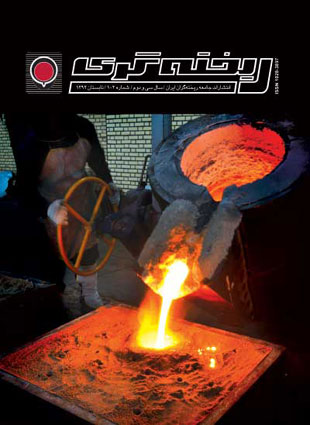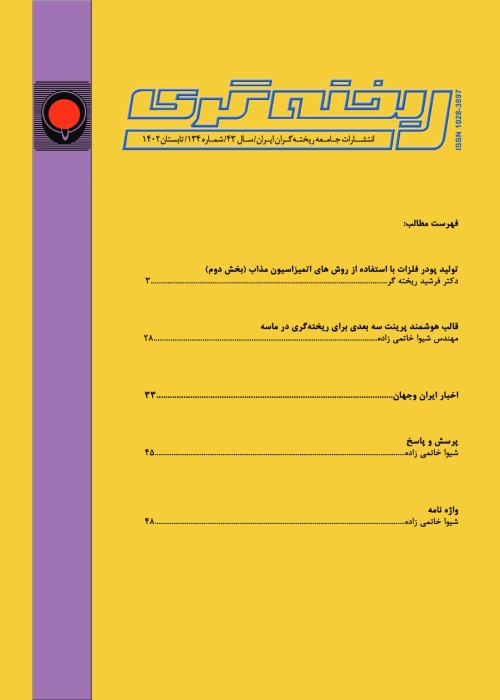فهرست مطالب

نشریه ریخته گری
پیاپی 101 (بهار 1392)
- تاریخ انتشار: 1392/04/03
- تعداد عناوین: 8
-
-
تحلیل چالش های توسعه علمی ریخته گری در ایرانصفحه 2
-
افزایش بهره وری در ماشینکاری قطعات چدن نشکن در صنایع خودروصفحه 8
-
اثر افزودن آنتی اکسیدان کاربید بور و منیزیم بر جرم های ریختنی آلومینا- منیزیا- گرافیت حاوی میکروسیلیسصفحه 17
-
مکانیزم سایش در چدن های نشکن آستمپر شده کاربیدی (CADI)صفحه 24
-
اثر عوامل ریخته گری در تولید فوم آلومینیمی A 356 بر رفتار تغییر شکل پلاستیک طی آزمون فشار تکصفحه 34
-
بررسی تاثیر کیفیت شمش آلومینیمی بر کیفیت محصولات تولیدیصفحه 45
-
اثر دما بر خواص غشای سرامیکی نسیکونی نانوساختار سنتز شده به روش سل- ژل با قابلیت تبادل یونصفحه 51
-
اثر عوامل فرآیندی بر ساختار سلولی کف- جامد آلومینیمی A356-SiC ریختگی و کمی سازی تخلخل آنصفحه 56
-
Evaluation of the Challenges of Scientific Development of Casting in IranPage 2Casting has important effects on the most selected technologies in Iranian Scientific Roadmap. Therefore, the scientific development of casting is necessary to achieve the objectives. In this paper, the challenges of of casting in Iran will be reviewed. Finally, it is proposed to develop scientific strategies and guidelines.Keywords: Scientific Audit, Casting, Scientific Development, Challenges, Iran
-
Productivity Improvement in Casting and Machining of Ductile Cast Iron Automotive PartsPage 8Production cost is one of the most important factors in each factory. Optimizing the machining operation steps and reducing manufacturing time, as well as effective use of resource are the most focused areas of any organization. Planning for optimum choices of cutting tools and reducing tools and transportation costs, is sometimes more important than the operation itself. Knuckle part of PRIDE car is one of the most critical parts in the car safety function, which is made of Nodular cast iron (GGG40), with high dimensional accuracy and various kinds of operations (Machining, Milling, boring …). In a non-automated production line, the production process includes over 20 different steps of work. This paper is trying to introduce the recent machining methods for machining of the above mentioned cast iron part, which causes increasing machining speed, reducing necessary human resource, as well as reducing machining time which finally results in effectively lowering the manufacturing costs and also enhancing production speed up to three times, comparing the old methods.
-
The Effect of Adding Boron Carbide and Magnesium Antioxidants on Alumina-Magnesia-Graphite Castable Containing Micro SilicaPage 17In order to research structure and properties of Alumina-Magnesia-Carbon castables; in this study, at the first, a composition based on tabular alumina aggregate with optimum size distribution were made and then physical and chemical properties of the body dried at 110 °C and baked at 1000 and 145 °C were studied. Then effect of adding different percentages of boron carbide and magnesium antioxidants in changes these properties was analyzed. In order to study the corrosion behavior of the samples, the techniques of SEM, EDX and XRD were used. The results showed that the role of boron carbide antioxidant in improving the physical and chemical properties of samples is due to the phases formed and dense layers and with increasing boron carbide antioxidant in castable composition, physical and chemical properties of the samples were increased. Due to high porosity in refractories, Magnesium has not proper role as an antioxidant.Keywords: Alumina, Magnesia, Carbon castables, antioxidants, boron carbide, tabular alumina
-
Wear Mechanism in Carbidic Austempered Ductile Irons (CADI)Page 24The wear mechanism of carbidic austempered ductile iron (CADI) were studied in the present work using a pin-on-disk wear test machine. The carbide formed using the metallic chiller during casting process and The samples austempered at (375ºC, 325ºC, 275ºC) for (2,20,60 Min). Results showed that the wear resistance increased with decreasing austempering time (up to 2min) at the low applied load of 8 N, while at the higher applied load the increase wear resistance was resulted from applying a longer austempering time (60 min). If was also found that the wear resistance increased with decreasing austempering temperature (until 275ºC) at all of the applied load. Result of Weight loss and structure of samples in austempering times and temperatures and seeing of wear surface, worn surface and wear debris of samples showed that in applied loads and sliding times, various mechanism will exhibit include adhesive, abrasive, fatigue, oxidative and lamination.Keywords: CADI, austempering, wear mechanism, carbide, retained austenite
-
Effect of Casting Parameters on the Plastic Deformation of A356 Aluminum Foam During Uniaxial Compression TestPage 34In this study an attempt was carried out to determine the effect of production parameters on the mechanical properties and energy absorption behavior of cast closed-cell A356 alloy foams under uniaxial compression test. For this purpose, three different A356 alloy closed-cell foams were synthesized at three different casting temperatures, 650,675 and 700o C by adding the same amounts of granulated calcium as thickening and TiH2 as blowing agent. Inorder to comparison and evaluation the effect of foaming agent type on morphology, bublles celullar walls, and mechanical properties of the foam, another closed-cell foam sample was cast by using CaCO3 at 700o C in the same conditions. Assesment of the cells morphology and the cells wall thickness were done by using Scanning Electron Microscope and uniaxial compression tests, were done to A356 foam samples. The results indicated that, the molten temperature and the foaming temperature during casting, play dominant role on the mechanical properties and the absorption energy of closed cell foam, in which, increasing casting temperature leads to distortion and shrink of the cells, and also micro tearing at bulles walls.These phenomena, increases stress local concentration at cellular wall that causes a drop in the mechanical properties. Energy absorption results of the lower density foams, that produced at casting temperature of 700 oC by using two different foaming agents revealed, at a densification strain of 50%, the energy absorption capacity of the produced foam by CaCO3 is more than 100% of the foam which applied TiH2 as gas releasing agent.
-
Effect of Quality of Ingot on the Quality of Aluminum Casting ProductsPage 45This Research was carried out in an automotive casting Plant which Produced cylinder Head From A356 Aluminum Alloy with high Scrap rate. They used Aluminum ingots from 3 different supliers. The results have shown a good agreement with the scrap rate data of final cast Product, and the problem of higher scrap rate was significantly reduced when the ingots of an A356 alloy with the highest oxide and gas content from supplier. In order to study the influence of transfer and degassing and melt holding time on the quality of cast Products, the Pressure reduce tests were conducted along the Production. The results shows that Pressure reduce test has a Potential to be used for routine melt quality control and reduction of Scrap rate.Keywords: Aluminum Melt Quality. Die casting, Reduce Pressure Test, Cylinder Head Scrap, A356 Aluminum Alloy
-
Effect of Temperature on the NASICON Nanostructure Ceramic Membrane Synthesized by Sol-Gel Method with Ion Exchange AbilityPage 51In this research, a NASICON-type (Na-Super Ionic Conductor) nanostructure based on Lithium, i.e. Li1.4Al0.4Ti1.6(PO4)3 (LATP), was synthesized through modified Pechini-type sol-gel method. Metal salts was used instead of conventional alkoxide, leading to the production of monophase nanostructure. X-Ray diffractometry (XRD) and scanning electron microscopy (SEM) were performed to investigate the phase analysis and the morphology of the produced powders, respectively. Moreover, Simultaneous Thermal Analysis (STA) was employed to determine the calcinations and crystallization temperatures to optimize the synthesis temperature. The modified Pechini-type method allowed obtaining well crystallized LATP at a much lower temperature and with a shorter synthesis time in comparison with the conventional solid state reaction.Keywords: Ceramic membrane, synthesis, NASICON, Lithium, sol, gel
-
Effect of Processes Parameters on Cellular Structure of the Cast A356-SiC Foam and Quantification of the PorosityPage 56In this investigation has been developed an analytical model for quantification of cellular structure of cast A356-SiC foam. In the first stage, effect of processes parameters, such as temperature and time of the foaming, and the SiC percentage on the cellular structure pattern of foams were measured. In next stage, phenomenon of drainage was quantified by measuring of density in foams longitudinal direction. Then by adding of Clemex-software the porosity structure of foam in transverse and longitudinal directions was analyzed, and then was developed a new mathematical model (S coefficient) for stability and homogeneity of the foam porosity structure. Effect of non-homogeneity, drainage, and defect of foam cellular structure on the mechanicalproperties can be quantified by the S coefficient. In order to verification of the model, ASTM E9 carried outfor some foam samples with homogenous and non- homogenous structure. The plastic deformation energy of foams based on the stress-strain curves was calculated and was compared with the S coefficient of each sample. Results shown, while the S coefficient was approximated to unity, the cellular structure will be more homogenous and increase the absorption energy.


